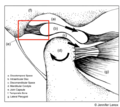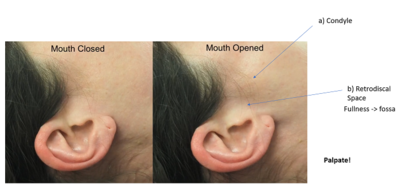◒
TMJ Examination: Difference between revisions
From WikiMSK
mNo edit summary |
|||
| (15 intermediate revisions by the same user not shown) | |||
| Line 1: | Line 1: | ||
{{ | {{partial}} | ||
==Anatomy== | ==Anatomy== | ||
| Line 8: | Line 7: | ||
File:TMJ Anatomy3.png | File:TMJ Anatomy3.png | ||
</gallery> | </gallery> | ||
==Inspection== | |||
#Oral exam | |||
#Head/chin deviations | |||
#*C curve occurs due to hypomobility, the mandible deviates to the involved side, then returns to centre | |||
#*S curve occurs due to hypermobility as a result of poor neuromuscular control. | |||
==Palpation== | ==Palpation== | ||
[[File:TMJ retrodiscal space.PNG|thumb|right|400px|Retrodiscal space]] | [[File:TMJ retrodiscal space.PNG|thumb|right|400px|Retrodiscal space]] | ||
#Retrodiscal space. Line your finger tips up of fingers 2 through 5. Palpate the right and left TMJ with the posterior finger at the tragus. Allow a slight inferior angle of finger alignment. | |||
#Coronoid Process: Begin with mouth closed, palpate inferior to the zygomatic bone. Ask the patient to open their mouth. If the coronoid process does not move forward to touch your finger then ask them to open further or adjust your finger location. Check all easily accessible coronoid aspects. Verbal cues are generally required for maintaining an open mouth. Palpation of the medial aspect can be accomplished intraorally if required. | #Coronoid Process: Begin with mouth closed, palpate inferior to the zygomatic bone. Ask the patient to open their mouth. If the coronoid process does not move forward to touch your finger then ask them to open further or adjust your finger location. Check all easily accessible coronoid aspects. Verbal cues are generally required for maintaining an open mouth. Palpation of the medial aspect can be accomplished intraorally if required. | ||
# | #Masseter | ||
==Movement== | |||
#Range of motion. normal jaw opening is ~4-7cm, with a wide range of normal<ref>Zawawi KH, Al-Badawi EA, Lobo SL, Melis M, Mehta NR. An index for the measurement of normal maximum mouth opening. J Can Dent Assoc. 2003;69(11):737-741</ref>. | |||
== See Also == | |||
[[TMJ Pain]] | |||
==Videos== | |||
<youtube>Nmg3xl13TY0</youtube> | |||
<youtube>upbs7Hm9tRQ</youtube> | |||
<youtube>MG_JqF1mNb0</youtube> | |||
==MCQs== | ==MCQs== | ||
| Line 48: | Line 67: | ||
||Origin is lateral border of mandibular ramus | ||Origin is lateral border of mandibular ramus | ||
- The maxilla | - The maxilla | ||
{Roughly how many fingers wide should your mouth open? | |||
|type="()"} | |||
- ~one | |||
- ~two | |||
+ ~three | |||
||Very wide range of normal ~4-7cm, Also check lateral deviation, https://www.ncbi.nlm.nih.gov/pubmed/14653940 | |||
- ~four | |||
- ~five | |||
{What other joint or joint complex should you examine? | |||
|type="()"} | |||
-The shoulder | |||
+The neck | |||
||The TMJ and neck are highly linked. cervical extension causes jaw opening, while flexion causes jaw closing. There is a neural link between the upper c spine and the trigeminal ganglion (e.g. cervicogenic headaches) | |||
-The ACJ | |||
-The SCJ | |||
{Does joint effusion on MRI correlate with pain? | |||
|type="()"} | |||
+ Yes | |||
||Degenerative changes do not correlate with pain or mobility | |||
- No | |||
</quiz> | </quiz> | ||
[[Category:Head | |||
[[Category:Head and Jaw]] | |||
[[Category:Examination]] | |||
==References== | |||
Latest revision as of 11:30, 4 March 2022
This article is still missing information.
Anatomy
Inspection
- Oral exam
- Head/chin deviations
- C curve occurs due to hypomobility, the mandible deviates to the involved side, then returns to centre
- S curve occurs due to hypermobility as a result of poor neuromuscular control.
Palpation
- Retrodiscal space. Line your finger tips up of fingers 2 through 5. Palpate the right and left TMJ with the posterior finger at the tragus. Allow a slight inferior angle of finger alignment.
- Coronoid Process: Begin with mouth closed, palpate inferior to the zygomatic bone. Ask the patient to open their mouth. If the coronoid process does not move forward to touch your finger then ask them to open further or adjust your finger location. Check all easily accessible coronoid aspects. Verbal cues are generally required for maintaining an open mouth. Palpation of the medial aspect can be accomplished intraorally if required.
- Masseter
Movement
- Range of motion. normal jaw opening is ~4-7cm, with a wide range of normal[1].
See Also
Videos
MCQs
References
- ↑ Zawawi KH, Al-Badawi EA, Lobo SL, Melis M, Mehta NR. An index for the measurement of normal maximum mouth opening. J Can Dent Assoc. 2003;69(11):737-741





